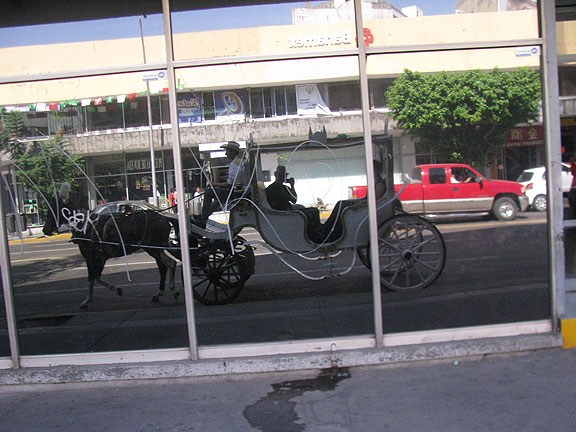
After strolling into the city center during a break we came back on a Calandria, a charming horse-drawn carriage still used in Guadalajara but mostly for tourism.
I just finished several days of networking and discussing in Guadalajara at the 10th annual “Towards Car-Free Cities” Conference. It’s not clear where the next one will be, or when, though my great friend Thiago Benicchio of Ciclo Cidade in Sao Paulo, Brazil, is planning one for 2013. I had a great time, as I always do at these kinds of confabulations. This is my second one, after my 2008 experience in Portland where I first met some of my Guadalajara friends.
They produced a number of charming promos like the one above, but we learned after the fact how close the whole thing came to being cancelled. Just three months before the Sept. 5 opening, there was no money, no publicity, and a barely functioning group producing the event. Two of the main organizers had dropped out for personal reasons, and a whole new team had to step into their absence and make it happen. Probably this was for the best, since now there are a number of women occupying key roles in the much more horizontal organizing group, and frankly, they did a fantastic job of producing the conference. Dozens of workshops with simultaneous translation, a good deal of media coverage, thousands of attendees during the week, and a real buzz around Guadalajara and even nationally across Mexico, all arose from their fine efforts.
The future is the target of this ongoing international effort to move us “towards car-free cities.” How do we consciously redesign cities to move away from the seemingly inevitable domination of the private automobile? What are the alternatives? What are the mechanisms to move us? Do we engage with government and policy-making, or do we build grassroots, direct-action movements, or both? And if both, how do they reinforce each other or not? And can we really talk about mobility and transport in the absence of a more comprehensive critique of how we reproduce life in all its facets?

We emerged from the light rail system to a closed amusement park with this tell-tale children’s ride, cars going round a gas pump! Perhaps this will be a relic someday!
My organizer friends gave me the great honor of giving my presentation in a most unusual location: in a pseudo-plaza amidst intersecting underground car tunnels! Somehow the organizers convinced a deputy mayor to sign off on closing one of the tunnels to cars, since the only access to the plaza is to walk or bicycle down one of the tunnel entrances on the roadway. About 300-400 people came, and the police diverted thousands of cars onto surface detours for the three hours of closure. Not surprisingly, this generated a fair amount of antagonism in the media, with journalists badgering the organizers (and me too, a little) about the inconvenience we “unjustly” created. But as I answered in various interviews, this kind of tension is actually quite productive. No one was really put out that far (Guadalajara is a big traffic jam, routinely), so another couple of hours of bad traffic can hardly be seen as a great tragedy. It’s actually perfectly “normal” here, as in most major cities. But because there was an identifiable “cause” of this road closure, the tension was productive, it generated questions, “who did this? what do they want? what is it to talk about ‘car-free cities’?” and so on. In fact, the media swarmed the conference organizers with questions and paid much more attention to the whole conference thanks to the unusual use of the subterranean plaza, and the consequent road closure. In other words, it worked like a charm!
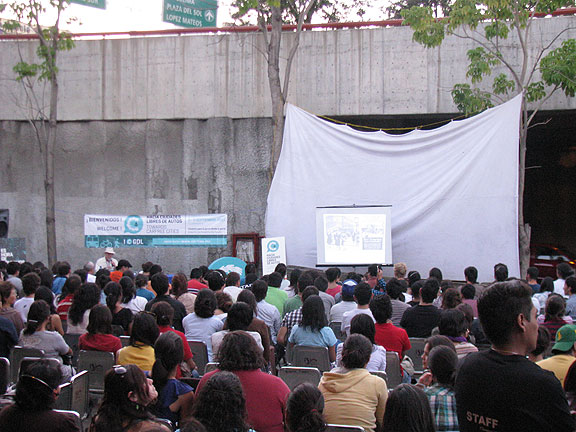
If you were in the back you probably couldn’t see very well… projecting onto the big sheet didn’t work in the bright evening light, so we moved a smaller screen into place.
The Conference demographics were skewed towards youth, with a surprising number of teens and folks in their 20s. I really enjoyed meeting a crowd of teenagers and learning that they had invented at their high school a “bike train” wherein they ride to school, going from house to house picking up their classmates until some 60-80 are riding together to school. Quite impressive! Most of the conference was held at Iteso University on the southern edge of Guadalajara, and that brought in hundreds of curious students to various workshops and lectures. Notably missing from the week’s events were the bike commuting construction workers and laborers, panaderos (bread deliverers) and other bike couriers, and the vast population of poor working class who depend on the widely disrespected public transit system.
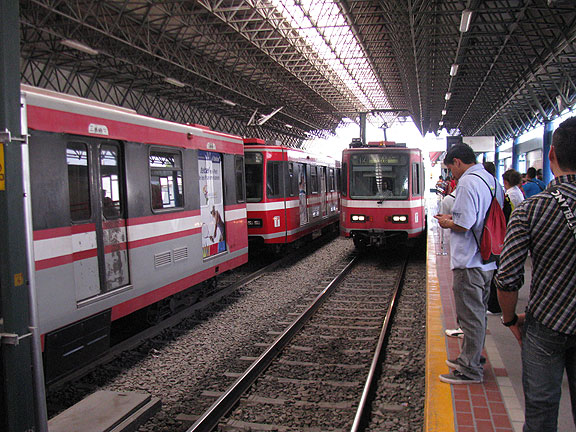
The underground light rail system worked fine for us, but we heard it is pretty horrible at rush hour.
Of all the policy wonks, transit geeks, and bicycle activists who were in attendance, my favorite speaker was Miguel Valencia. He’s a chemical engineer who has been working at the Autonomous University of Mexico and he has an extremely articulate critique which goes well beyond the typical clichés of transit wonkdom. He built a much broader and deeper edifice on his rejection of the principles of modernism and industrialism. He went on to say that life has to slow down and the very notion of “the job” is part of the problem. Rather than belabor the obvious problems of cars and cities tied up in traffic, he emphasized the deeper assumptions about economic growth and urban design that are rooted in pre-WWII modernist thinking. He clearly advocated a “relocalization” agenda, putting transport into a larger agenda of social transformation and transition. I listened to him in Spanish (foregoing the translation headphones) so my understanding of him was well short of 100%, but later he mentioned that he had been in communication with Jan Lundberg (of Culture Change) and Richard Register (Berkeley) for at least a couple of decades. Clearly his thinking is rooted in a green city, post-petroleum, sensibility. His critique was as much of the capitalist organization of life as it was the obvious depradations of automobiles and the infrastructure that supports them.
Roxana Kreimer of Argentina is the author of a book “The Tyranny of the Automobile,” and she gave the final keynote talk. I was not impressed, in spite of attending with relatively high expectations. Regrettably she lost me early, with bad use of statistics (comparing the number of deaths in autos to those in trains to make a case that cars are worse), and a repetitive and all-too-familiar critique of cars based on the death, disease, and societal mayhem they are directly responsible for. We left before she was finished, shaking our heads at the “sky-is-falling” Helen Calidicott approach that pounded the audience with arguments about cars causing fatalities and injuries, as though we all didn’t already know it.
Which highlights the biggest problem of these gatherings—too many people preaching to the converted, repeating the same tired points that have been said so many times previously. As Thiago wrote me in an email a couple of days before I got here, after he’d arrived and had been quickly swept up in local activities in Guadalajara:
“It’s really global and people are really starting to talk [about] the same things all over the world, at different levels of perception. I just don’t know how much it can reach the “outer world” and how much we’re talking [to] ourselves [about] things that we already know. At least, it’s a great exercise to spread the words and thoughts.”
It is heartening to see the surge of visionary activism here in Guadalajara, and to realize it is happening in fits and starts in places as diverse as Sao Paulo and Oslo, Norway, San Francisco and Quito, Ecuador. We got reacquainted with Anna Nygard here too, whom we’d first met in Oslo (she’s actually a Swede), where she’s helped launch the Planka.nu project there. I wrote about planka during my Scandinavian trip in 2009, a group that is committed to free transit for all (they favor having taxes pay for all public transit) and supportive of fare evasion (they offer an insurance policy against fare evasion tickets!). Unfortunately we missed her Talk but everyone said it was excellent.

We saw this odd religious flyer posted to the wall… Guadalajara’s congested streets might “drive” a bicyclist to religion I guess!
Old friend Jason Meggs was here too. Imagine my surprise to walk in on his workshop to find him showing a series of impenetrable powerpoint slides and advocating for more on-the-ground statistical research about how people get around! Here’s one of the stalwarts of Bay Area activism, who was a crucial character in getting the bike/ped lane added to the new Bay Bridge east span with his incessant pressure and rides across the bridge a decade ago. Now he’s living in Bologna, Italy, where the University is supporting him while he studies eastern European cities and their relationship to bicycling. But Jason has long been a guy seeking that balance between wonky advocacy work and the soaring passions that sent him to jail dozens of times in the 1990s, so it was lovely to see him still going.
Eric Britton, founder of Carfree Day, gave a week’s worth of daily workshops to local bureaucrats, which somehow managed to cover most of the Conference costs. He made a splash in the Saturday newspaper, denouncing local politicians for failing to take advantage of all the free, high quality “transportation consultants” on hand during the conference. And he insisted that he could turn Guadalajara into the most bike and ped-friendly city in Latin America in a month, with the funds being squandered on another of a series of pointless bridges being built over big intersections around the city.
There is no question that a new vision of modernity and the future is taking shape globally, and one of the arenas of this emergence is the movement for bicycles and car-free cities. Miguel Valencia’s critique of modernism was on point, but he didn’t try to reclaim or reinvent the concept, perhaps because our confidence in a better future is at low ebb. It is hard to believe the future will be better in light of the collapse of social democracies in the face of relentless neoliberal redistribution of wealth to the rich, and the rising tide of climate chaos to boot. But it is precisely in the transition towns idea, for relocalization and resilience, reduced consumption/waste of energy and other resources, an extension of social rights to everyone regardless of nationality or race, etc., that we CAN imagine a world much better than the one we’re in now. No doubt the “Car-Free Cities” movement will have to break out of its dependence on a narrow slice of the population to contribute to this broader social transformation. And after ten years of meeting, this latest iteration of the Conference held many clues as to the directions that such a break-out might take.
My sweetheart Adriana Camarena brought a great idea forward that emerged from a conversation with her mother: the young people who attend could be encouraged to speak to the maids and gardeners who work at their parents’ homes, and insist that they be paid a regular day’s wages to come to such a future Conference, rather than working. Who better to describe the failures of existing transit options and to envision their radical improvement than those people who depend on buses and other options every day? They spend up to 2 or 3 hours a day moving across vast cities to get to low-wage jobs in rich people’s homes. Imagine allying with them and inviting them into the process of social transformation, of which the transit component is just one (vital) part? Clearly the car-free agenda needs to integrate more aggressively a class component, and this might be a good beginning…


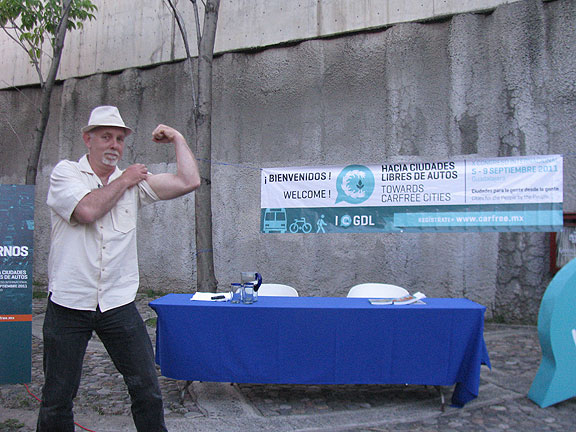

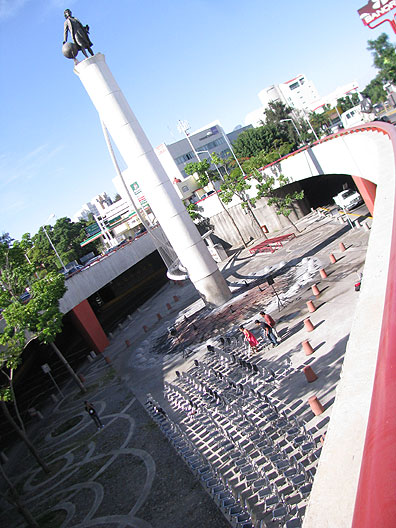
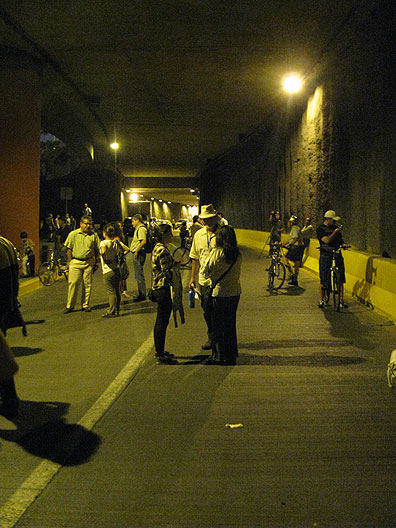
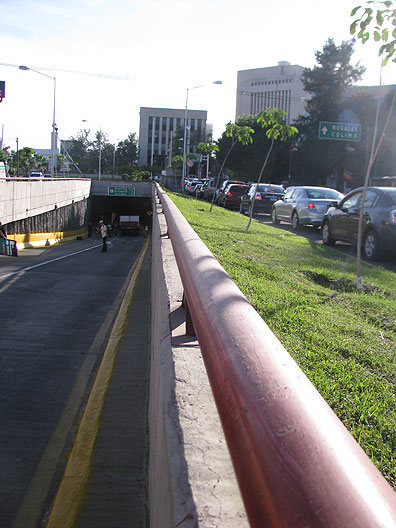
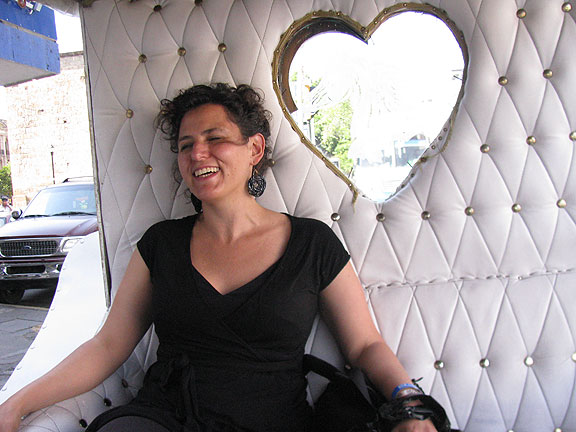
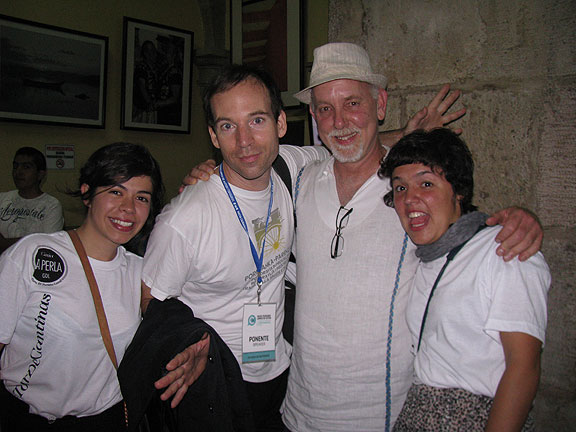
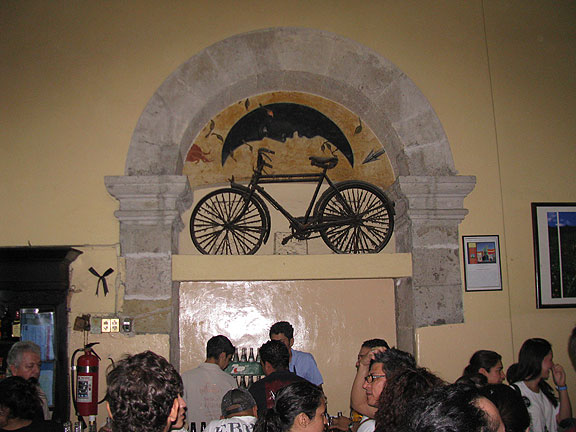
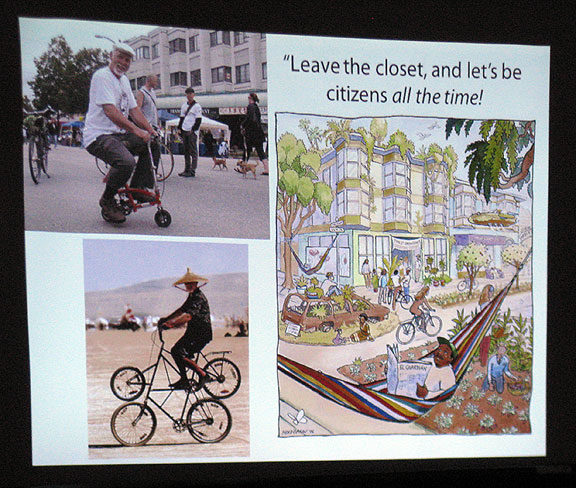











Chris, thanks for your blog post and your wonderful talk in the tunnel. As part of the Carfree team (I’m the guy who set up the audio and projection), I’m proud to have had you as part of this crazy experiment, no better talk than “The Freeway Revolt” to be given during a freeway revolt of sorts.
I agree with your comments on Roxana’s talk. Even though many of that stuff may be true, many of us already know that, and those who don’t will mostly be turned off by such extreme and negative comments. Nothing better than positive reinforcement. For example, the great suggestion from our friend from Portland (forgot her name =S) who suggested bike commute contests within companies. I’m planning to start such a contest in my office!